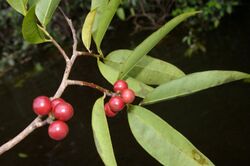Biology:Pseudoxandra polyphleba
| Pseudoxandra polyphleba | |
|---|---|

| |
| Photograph of Pseudoxandra polyphleba with fruit.[1] | |
| Scientific classification | |
| Kingdom: | Plantae |
| Clade: | Tracheophytes |
| Clade: | Angiosperms |
| Clade: | Magnoliids |
| Order: | Magnoliales |
| Family: | Annonaceae |
| Genus: | Pseudoxandra |
| Species: | P. polyphleba
|
| Binomial name | |
| Pseudoxandra polyphleba (Diels) R.E.Fr.
| |
| Synonyms | |
|
Cremastosperma polyphlebum (Diels) R.E.Fr. | |
Pseudoxandra polyphleba is a species of plant in the family Annonaceae. It is native to Bolivia, Brazil , Colombia, French Guiana, Guyana, and Peru.[3] Ludwig Diels, the German botanist who first formally described the species using the basionym Unonopsis polyphleba, named it after the distinctive veins (Latinized form of Greek φλέβα, phléba)[4] in its leaves.[5]
Description
It is a tree reaching 4 to 15 meters in height. Its dull papery leaves are 10–19 by 3–6 centimeters and come to a point at their tips. The leaves are hairless on their upper and lower surfaces, but can have small warty bumps. The leaves have 10–15 distinct, straight secondary veins emanating from the primary vein. Its petioles are 2–7 millimeters long. Its flowers are solitary or in pairs and axillary. Each flower is on a pedicel 2-5 millimeters long. Its flowers have 3 oval-shaped sepals that are 1–2 by 2–3 millimeters. The outer surface of the sepals is hairless or slightly hairy. Its 6 petals are arranged in two rows of 3. The outer petals are white to yellow and 4–10 by 3–5 millimeters. The outer petals are hairless on their outer surface. The inner petals are similarly colored and 3–8 by 3–5 millimeters. The inner petals are smooth on their outer surface. It has numerous stamens that are 1.5–1.7 millimeters long. Each flower has 2–20 monocarps that are yellow, red, or near black at maturity and 10–15 millimeters wide. Its brown seeds are 8–13 by 7–12 millimeters.[6]
Reproductive biology
The pollen of P. polyphleba is shed as permanent tetrads.[7]
References
- ↑ "Pseudoxandra polyphleba (Diels) R.E. Fr.". Tropicos.org. Missouri Botanical Garden. n.d.. https://www.tropicos.org/name/1600718.
- ↑ Botanic Gardens Conservation International (BGCI).; IUCN SSC Global Tree Specialist Group (2019). "Pseudoxandra polyphleba". IUCN Red List of Threatened Species 2019: e.T145665624A145665626. doi:10.2305/IUCN.UK.2019-2.RLTS.T145665624A145665626.en. https://www.iucnredlist.org/species/145665624/145665626. Retrieved 20 November 2021.
- ↑ "Pseudoxandra polyphleba (Diels) R.E.Fr.". The Trustees of the Royal Botanic Gardens, Kew. n.d.. https://powo.science.kew.org/taxon/urn:lsid:ipni.org:names:211623-2.
- ↑ Stearn, William (2004). Botanical Latin. Portland, Ore. Newton Abbot: Timber Press David & Charles. ISBN 9780881926279.
- ↑ Pilger, R. (1905). "Beiträge zur Flora der Hylaea nach den Sammlungen von E. Ule. Unter Mitwirkung namhafter Fachgenossen herausgegeben" (in German, Latin). Verhandlungen des Botanischen Vereins für die Provinz Brandenburg 47: 100–191. https://www.biodiversitylibrary.org/item/189279.
- ↑ Maas, Paul J.M.; Westra, Lubbert Y.Th. (2003). "Revision of the Neotropical genus Pseudoxandra (Annonaceae)". Blumea - Biodiversity, Evolution and Biogeography of Plants 48 (2): 201–259. doi:10.3767/000651903X674955. ISSN 0006-5196. http://www.repository.naturalis.nl/record/524896.
- ↑ Walker, James W. (1971). "Pollen Morphology, Phytogeography, and Phylogeny of the Annonaceae". Contributions from the Gray Herbarium of Harvard University 202 (202): 1–130. doi:10.5962/p.272704.
External links
Wikidata ☰ {{{from}}} entry
 |


